





Finding the right influencer marketing software can be tricky. While tools like Stella are useful for influencer discovery and campaign management, many marketers point out three recurring issues: limited integrations with eCommerce platforms, rigid pricing models that don’t scale well for growing teams, and a lack of automation that makes running larger campaigns cumbersome.
Because of this, many brands—especially D2C and eCommerce players—are searching for Stellar alternatives that deliver deeper data, stronger integrations, and better ROI tracking.
Among all the options, Influencer Hero stands out as the best alternative to Stellar. It combines influencer discovery, outreach automation, affiliate tracking, and UGC management in one clean dashboard, all while offering flexible pricing and premium customer support. For fast-growing D2C brands, it’s a scalable solution that ensures no time or budget is wasted.
According to the latest 2025 data from platforms like CreatorIQ, Upfluence, and Grin, brands are doubling down on ROI-focused influencer tools, especially those with Shopify, WooCommerce, and Amazon integrations.
Here are the top 10 Stellar alternatives we’ll explore in this article:
While Stellar offers a streamlined way to manage influencer relationships, many users quickly run into limitations that impact scaling and ROI. Below are four common pain points that drive brands to explore stronger alternatives
Stellar doesn’t integrate natively with key platforms like Shopify, WooCommerce, or Amazon, making it harder for D2C brands to track ROI and manage affiliate campaigns directly.
Marketers report that Stellar feels manual-heavy. From influencer outreach to campaign tracking, many workflows lack automation, leading to wasted time when scaling campaigns.
Stellar’s pricing model is restrictive for smaller and mid-sized teams. Users mention that it doesn’t scale well with usage, forcing them to overpay as their influencer programs grow.
Compared to competitors like CreatorIQ and Grin, Stellar’s reporting is limited. Users often turn to external spreadsheets or analytics tools to track performance, which creates inefficiencies and incomplete data visibility.
Our comparison focuses on several key aspects:
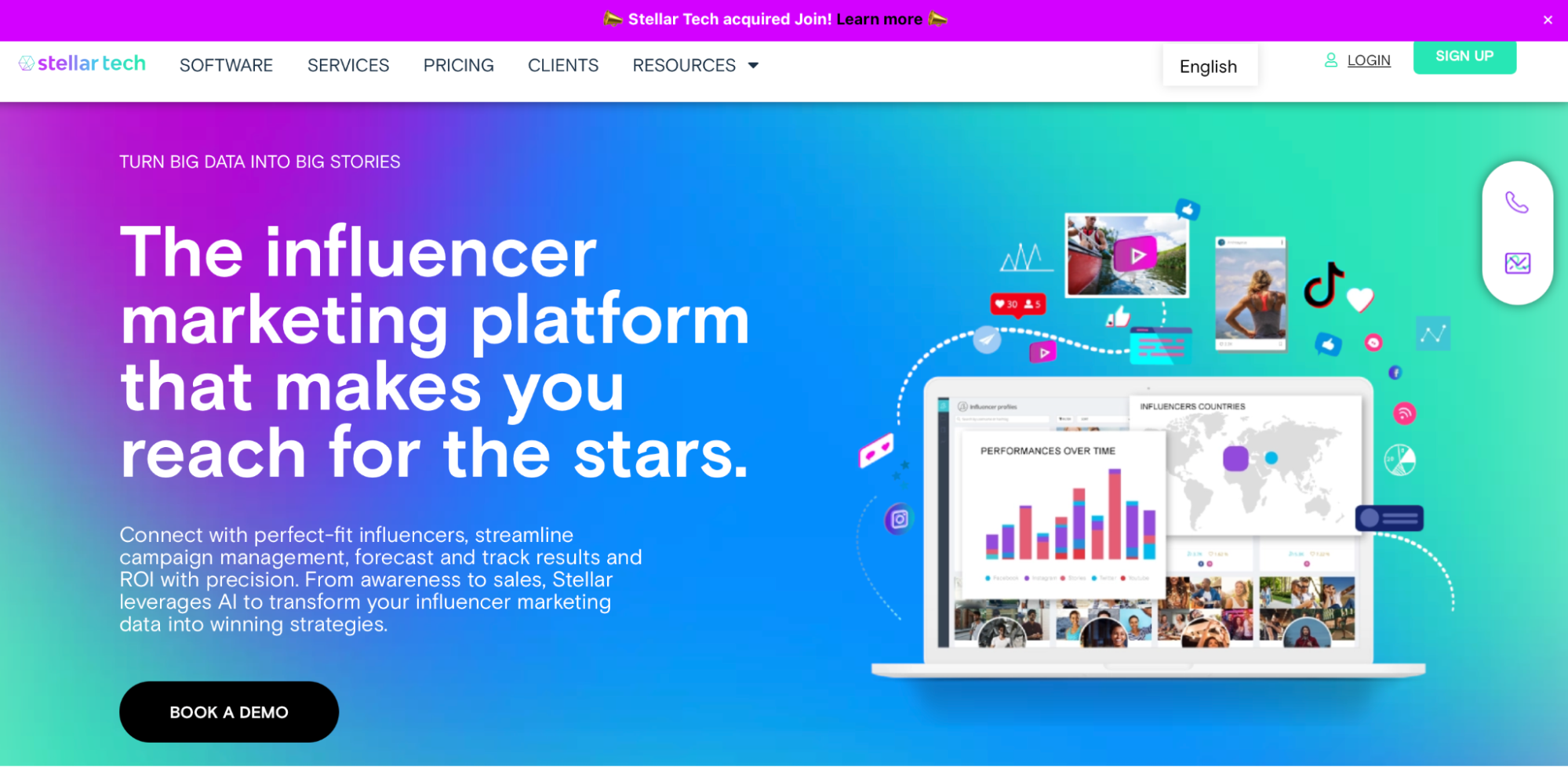
Best For: In-house teams and agencies that want modular, pay-for-what-you-need influencer software with audience authenticity checks, forecasting and sentiment analysis for ROI-driven campaigns across the major social platforms.
Platform Coverage: Instagram, TikTok, YouTube, Facebook and X/Twitter
Pricing: Modular, tiered by number of influencers; you can switch plans monthly (no annual lock-in). The lower plan starts at €89/month (For 25 influencers). Brands also have add-on modules (Projects, Reports, Discovery). A calculator on the pricing page provides a personalized quote; tiers scale by influencer count.
Reviews: 4.5 / 5.0 (Capterra)
Ease of Use (UX/UI): Reviewers consistently call Stellar “very easy to use,” noting that most teams get comfortable within a day thanks to clear workflows and ready-to-use reports. Several highlight how automatic capture/saving of posts and Stories reduces manual screenshots. A few wish for more customizable report styling and deeper CRM options.
Customer Support: Feedback describes “fast and personal communication” with helpful onboarding; users say the team is “always available” via chat to troubleshoot and iterate on needs. Some reviews mention occasional bugs or region-specific limitations, but praise quick resolutions.

Best For: D2C and eCommerce brands that want an all-in-one influencer marketing platform with deep integrations, automated workflows, and ROI-focused campaign management. Ideal for scaling teams that need multi-platform coverage with minimal manual effort.
Platform Coverage: Instagram, TikTok, YouTube, Facebook, Pinterest, Snapchat, X (Twitter), and Twitch.
Pricing:
All plans include core features and are billed monthly with no annual lock-in required.
Reviews: 5.0 / 5.0 (Capterra)
Ease of Use (UX/UI): Influencer Hero is known for its intuitive design and user-friendly dashboard. Users highlight streamlined campaign boards, automated workflows, and customizable email templates that make scaling campaigns fast and efficient. The Chrome extension also adds real-time insights for quick influencer evaluation.
Customer Support: Customer support is one of Influencer Hero’s strongest differentiators. The platform delivers 24/7 real-human live chat, responsive email support, and a rich Help Center with written guides and video tutorials. Every plan includes a dedicated account manager from day one, with optional strategy consultations. Pro plan users also gain access to a private Slack channel for continuous, faster support.
Stellar and Influencer Hero both help brands manage influencer campaigns, but they diverge significantly in pricing flexibility and depth of features. Stellar uses a modular pricing system starting at €89/month, but costs can quickly escalate when adding modules like Discovery or Reporting. Influencer Hero, by contrast, offers straightforward tiered plans starting at $649/month with all core features included—making it easier for brands to budget without hidden add-ons.
When it comes to campaign execution, Stellar excels at modular reporting and sentiment analysis but lacks native eCommerce integrations and automation depth. Influencer Hero integrates directly with Shopify and WooCommerce, automating gifting, tracking, and payments while layering in AI-powered outreach and predictive analytics. This makes it especially strong for D2C and eCommerce brands looking for measurable ROI without heavy manual oversight.
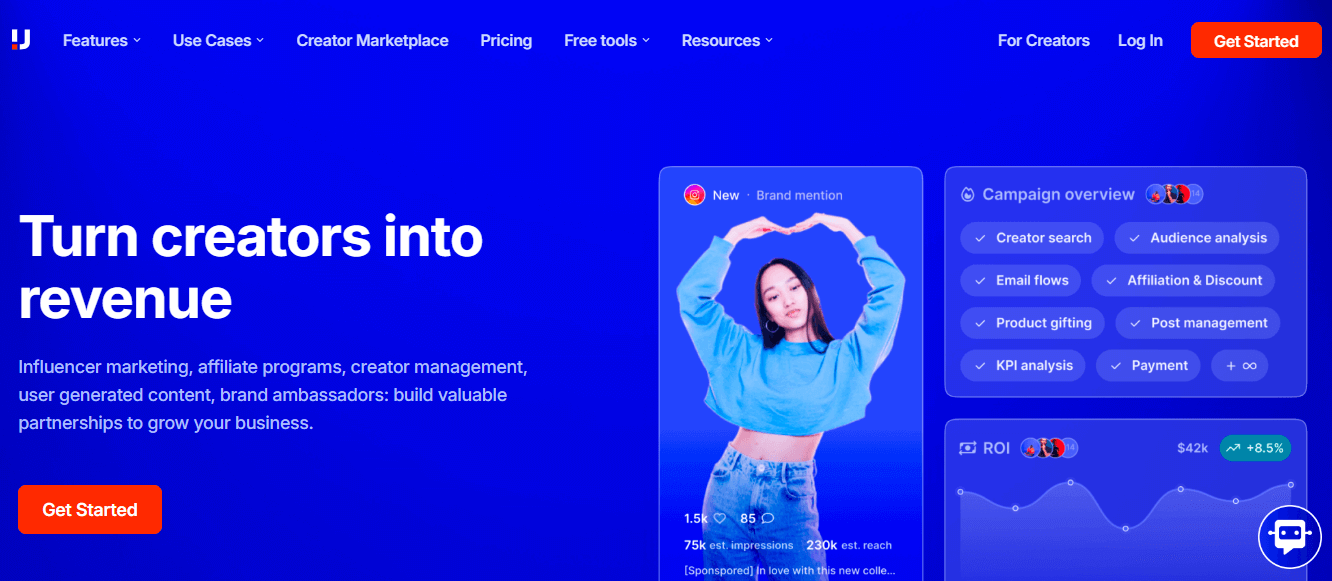
Best For: E-commerce brands, particularly Shopify and Amazon sellers, that want strong attribution and ROI tracking from influencer campaigns.
Platform Coverage: Instagram, TikTok, YouTube, X (Twitter), Twitch, Pinterest, and WordPress blogs.
Pricing:
Reviews: 4.3 / 5.0 (G2)
Ease of Use (UX/UI): Upfluence offers robust functionality but comes with a learning curve, especially for first-time influencer platform users. The platform’s extensive data and advanced filters make it powerful but can feel overwhelming for beginners. Once set up, the workflows and reporting are considered reliable and scalable.
Customer Support: Support is available via onboarding sessions, email, and account managers. While proactive for enterprise clients, smaller users report that support feels less accessible compared to more hands-on competitors like Influencer Hero.
Stellar’s modular pricing starts low but quickly adds up as features like Discovery and Reporting are unlocked. Upfluence, though more expensive at $1,276/month, bundles influencer discovery, outreach, CRM, affiliate tracking, and payments into a single platform, offering more value to scaling teams.
The biggest difference lies in eCommerce support: Stellar lacks Shopify or Amazon integrations, while Upfluence is built for them. For brands that want direct ROI attribution and stronger affiliate management, Upfluence stands out as the stronger option, especially for D2C and online retailers.
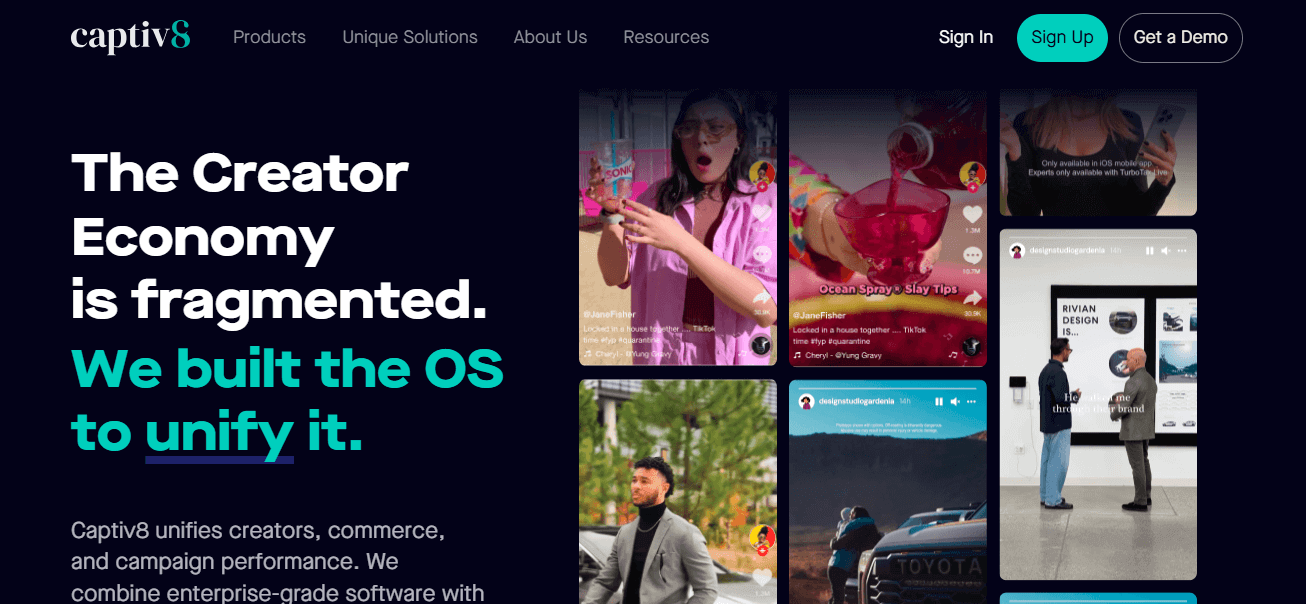
Best For: Brands and agencies that want enterprise-level influencer campaign management with advanced audience insights and a strong focus on paid media amplification.
Platform Coverage: Instagram, TikTok, YouTube, Facebook, X (Twitter), and Twitch.
Pricing: Captiv8 offers enterprise-focused plans with a significant investment required:
Reviews: 4.5/5.0 (Capterra)
Ease of Use (UX/UI): The platform provides a sleek and professional interface, but its advanced feature set can be overwhelming for first-time users. Once configured, marketers note that campaign tracking and reporting are highly efficient and scalable.
Customer Support: Captiv8 offers onboarding sessions, dedicated account managers, and email/chat support. Enterprise clients highlight proactive strategic guidance, while smaller teams report longer wait times for support responses.
Stellar’s appeal lies in its modular and more affordable entry pricing, making it easier for smaller brands to get started. Captiv8, by contrast, caters to mid-market and enterprise clients with a data-rich platform, deeper sentiment analysis, and paid media amplification—features not offered by Stellar.
For teams prioritizing simplicity and cost efficiency, Stellar is the lighter option, while brands that demand enterprise-grade analytics, cross-platform insights, and amplification tools will find Captiv8 better suited to their needs.
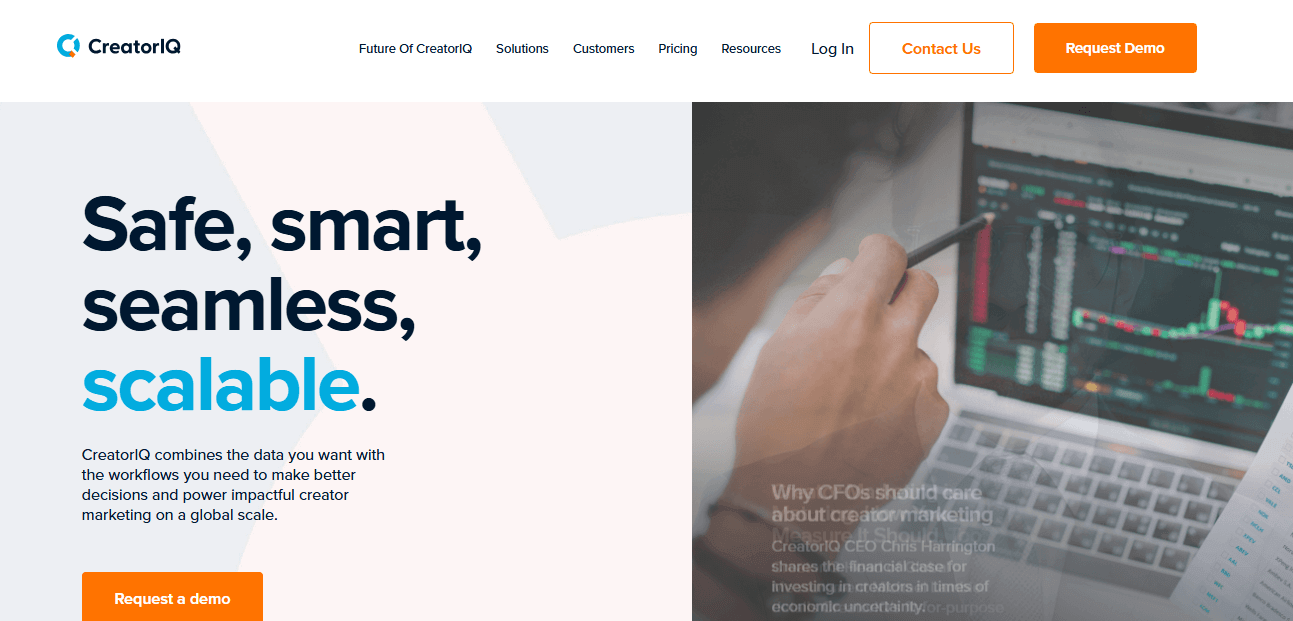
Best For: Enterprise brands and global agencies that want an end-to-end influencer marketing solution with advanced analytics, strong social platform partnerships, and robust compliance.
Platform Coverage: Instagram, TikTok, YouTube, Facebook, Pinterest, Twitch, and X (Twitter), with strong global data access (except some Chinese regions).
Pricing:
Reviews: 4.6 / 5.0 (G2)
Ease of Use (UX/UI): CreatorIQ offers a polished interface with advanced customization options. However, the platform’s scale means it can feel complex at first, requiring training and onboarding. Once configured, its live dashboards and reporting tools are highly valued by enterprise teams.
Customer Support: Each client is assigned a dedicated implementation manager and customer success team. Users value the quarterly strategy planning and strong relationships CreatorIQ maintains with social platforms, which provide early access to new features like YouTube Shorts or TikTok updates.
Stellar is designed for smaller teams with modular pricing that can start under €100/month, while CreatorIQ begins at $35,000 annually and scales up to $200,000 for enterprise clients. This makes Stellar far more accessible for startups and smaller brands, whereas CreatorIQ is tailored for global organizations managing thousands of creators.
Feature-wise, Stellar offers straightforward campaign tracking and reporting, but lacks the enterprise-grade capabilities of CreatorIQ, such as advanced CRM, tax-compliant payments, and API-level integrations with Meta, TikTok, and YouTube. For brands that need simplicity, Stellar suffices, but for large enterprises requiring scalability, governance, and advanced analytics, CreatorIQ stands out as the stronger choice.
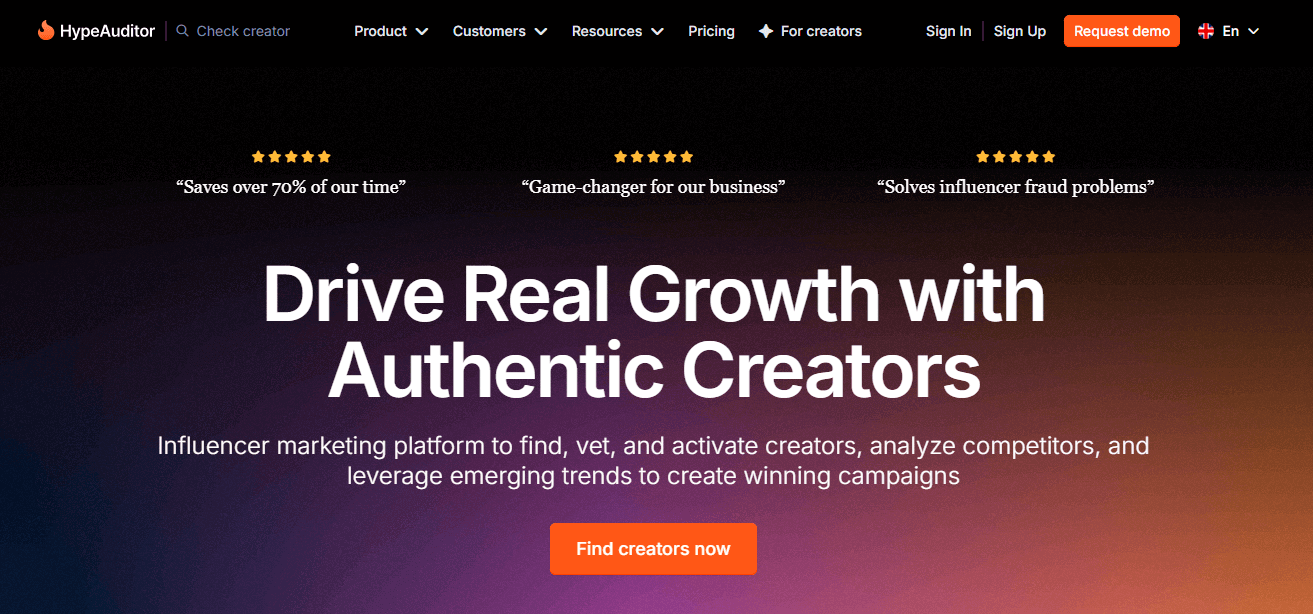
Best For: Brands and agencies seeking deep influencer discovery and auditing tools, especially those that prioritize audience authenticity and competitive insights before launching campaigns.
Platform Coverage: Instagram, TikTok, YouTube, Twitch, X (Twitter), and Snapchat.
Pricing:
Reviews: 4.5 / 5.0 (G2)
Ease of Use (UX/UI): The interface is data-heavy but intuitive once set up. Marketers appreciate the breadth of discovery filters and competitive intelligence tools, though some note that beginners may require onboarding or training to fully maximize the platform’s capabilities.
Customer Support: HypeAuditor provides onboarding, training sessions, and responsive email/chat support. Enterprise clients receive priority assistance, while smaller teams report slower response times compared to competitors.
Stellar offers a more affordable entry point with modular pricing, while HypeAuditor’s plans start around $10,000 annually, making it less accessible for smaller brands. However, HypeAuditor stands out with its powerful discovery, competitor analysis, and fraud detection features, which Stellar lacks.
For teams seeking simplicity and cost efficiency, Stellar provides a lighter option. In contrast, HypeAuditor is better suited for data-driven brands and agencies that need advanced auditing, authenticity checks, and competitor benchmarking to refine their influencer strategies.
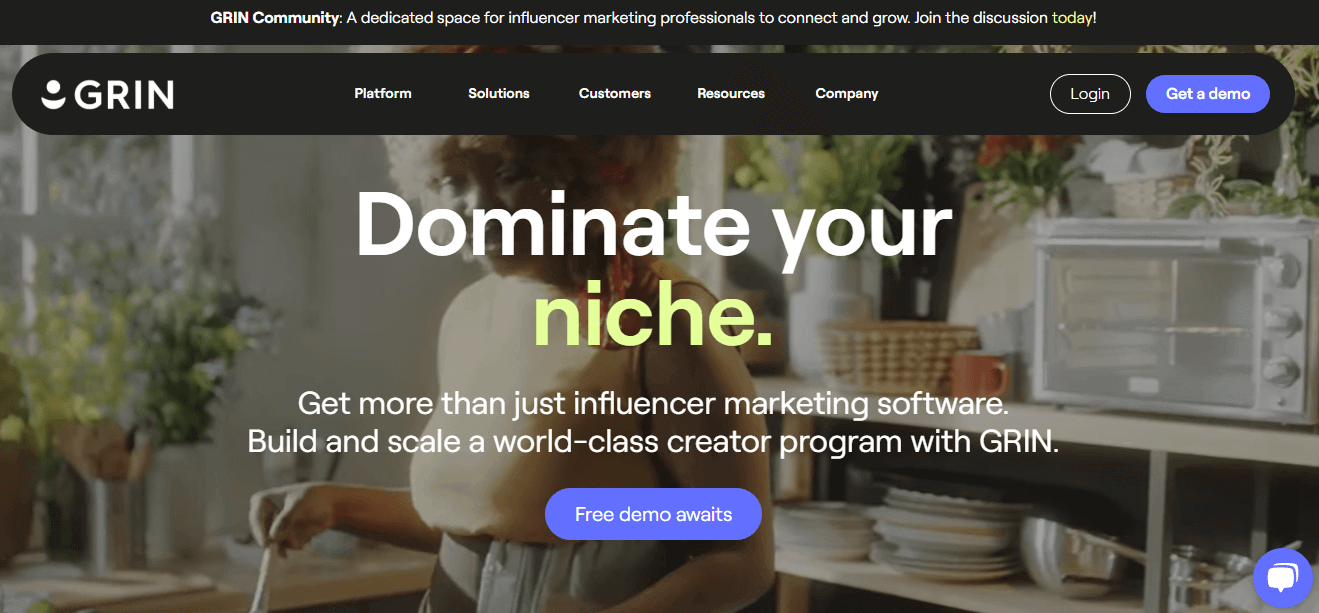
Best For: E-commerce brands using Shopify, WooCommerce, or Magento that want a platform centered on influencer partnerships, affiliate marketing, and direct sales attribution.
Platform Coverage: Instagram, TikTok, YouTube, Facebook, and Twitch
Pricing: Grin operates on a custom pricing model, with annual contracts typically starting around $25,000–$30,000/yeardepending on the number of creators and features required. Exact pricing is tailored for each client.
Reviews: 4.5 / 5.0 (G2)
Ease of Use (UX/UI): The interface is clean and designed for eCommerce teams, with strong focus on sales tracking and affiliate payouts. However, some users note that influencer discovery tools are less intuitive and limited compared to data-first platforms like HypeAuditor or CreatorIQ.
Customer Support: Grin provides dedicated account managers, onboarding sessions, and ongoing support. While praised for helpful implementation, some users report slower response times once onboarding is complete.
Stellar offers lower-cost modular pricing, making it more approachable for smaller teams, but it lacks the deep eCommerce focus that Grin provides. Grin is built specifically for online retailers, with strong Shopify and WooCommerce integrations that enable affiliate management, automated gifting, and ROI tracking at the sales level.
For brands looking for simplicity and affordability, Stellar is a lighter solution. For eCommerce-focused companies prioritizing affiliate programs and conversion tracking, Grin delivers a more specialized and powerful option.

Best For: Brands and agencies that prioritize influencer discovery and audience analytics at scale. Ideal for teams looking to tap into new regions or niches with a data-driven approach.
Platform Coverage: Instagram, TikTok, YouTube, and Twitch, with a focus on public creator data across all major markets.
Pricing:
Reviews: 4.7 (G2)
Ease of Use (UX/UI): Users describe the platform as straightforward and efficient, with fast search functionality and clear audience breakdowns. However, since Modash is primarily discovery-focused, users often need to rely on external tools for outreach and campaign management.
Customer Support: Support is responsive and accessible via live chat, email, and onboarding calls. Customers highlight fast response times and a willingness to implement feature requests, which makes it popular among growing teams.
Stellar provides more of an all-in-one campaign approach with reporting, CRM, and content tracking, but its discovery features are limited compared to Modash. Modash’s strength lies in its vast database of over 200M+ creators and deep audience insights, making it a superior choice for brands focused on discovery and vetting.
For teams that need simple campaign execution at a lower cost, Stellar is sufficient. But for marketers prioritizing discovery power and global reach, Modash offers far richer data and scalability.
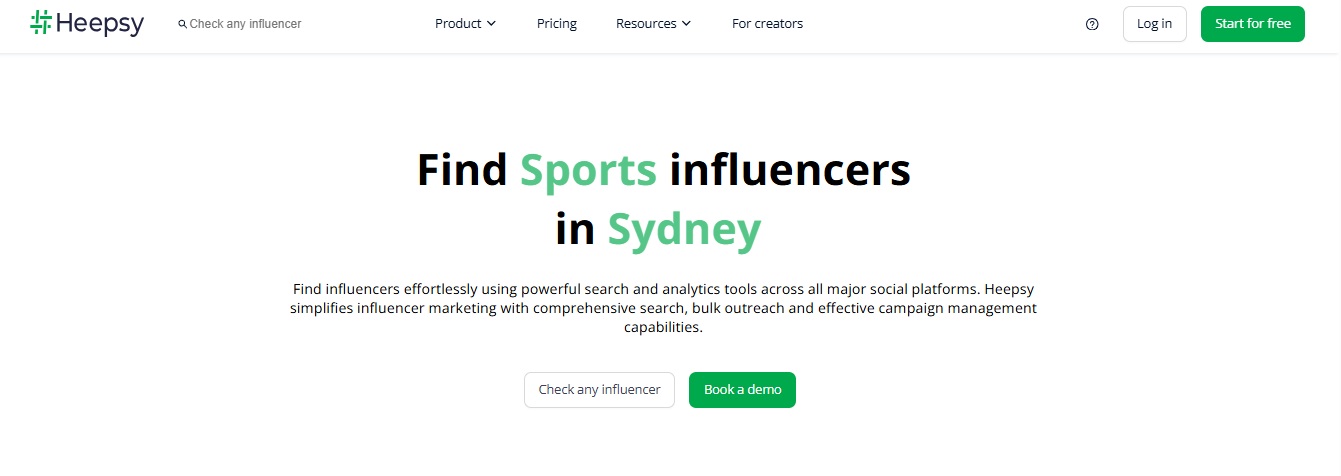
Best For: E-commerce brands and agencies that want a cost-flexible solution for influencer discovery, outreach, and campaign tracking. Especially useful for Shopify-powered brands running affiliate campaigns.
Platform Coverage: Instagram, TikTok, YouTube, and Twitch, with global coverage of ~50 million influencers.
Reviews: 4.5 / 5 (G2)
Ease of Use (UX/UI): The platform is designed to be straightforward, with multi-filter searches and Kanban-style CRM boards. Users note it is easy to manage campaigns end-to-end, though sales reporting is only available on the Advanced plan.
Customer Support: Heepsy offers helpful onboarding calls, email/chat support, and access to extra outreach templates upon request. Users value the responsiveness of the team, especially when scaling affiliate campaigns.
Stellar offers modular pricing starting at €89/month, but its influencer discovery tools are narrower compared to Heepsy’s massive 50M+ creator database. Heepsy stands out with its flexible, cancel-anytime pricing and robust global search filters.
However, Stellar provides stronger built-in analytics and reporting, while Heepsy locks its Shopify integration and sales tracking behind the Advanced plan. For teams prioritizing global discovery and flexibility, Heepsy is stronger, whereas Stellar works better for brands focused on streamlined reporting and sentiment analysis.
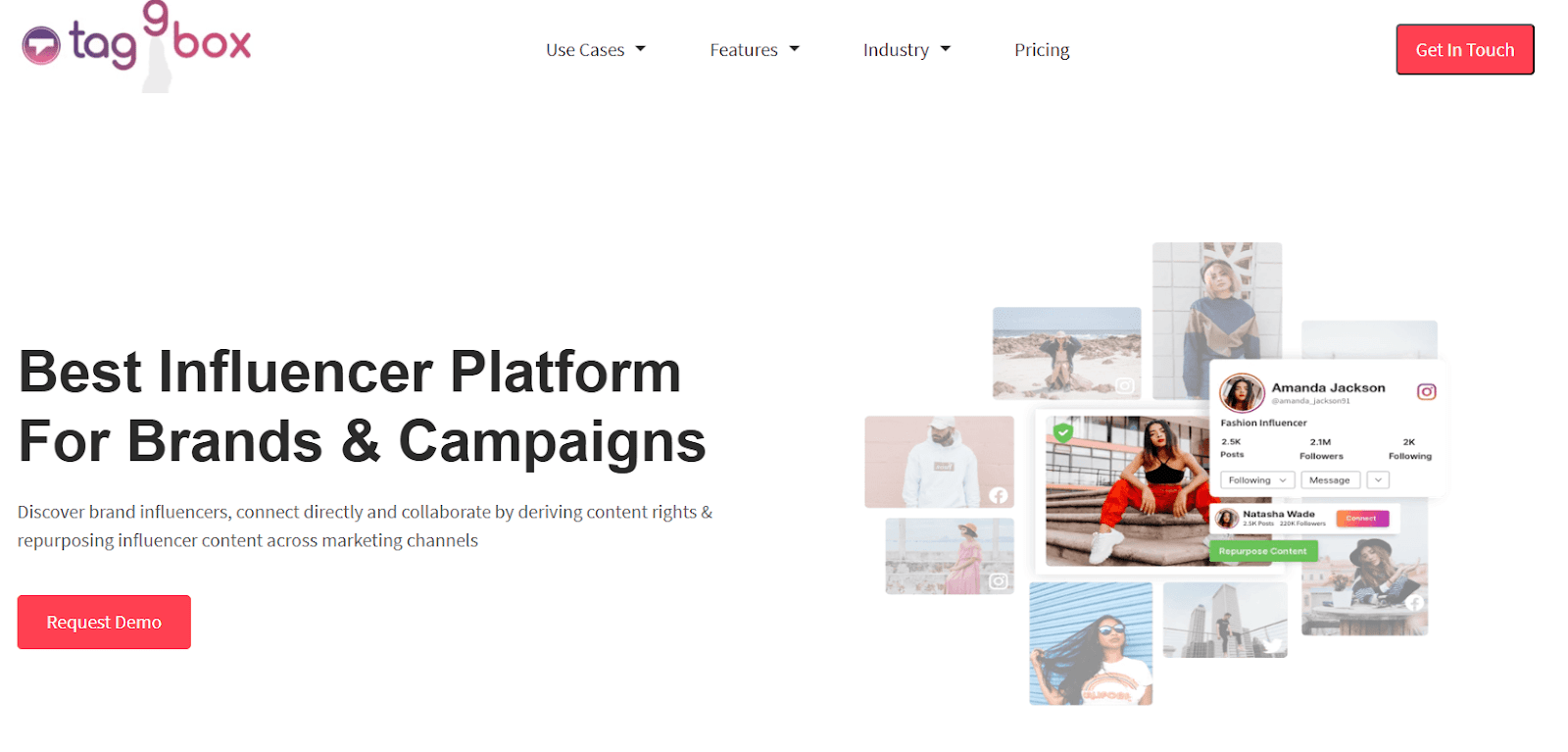
Best For: Brands, agencies, and organizations that want to manage and repurpose user-generated content (UGC) while also discovering influencers. Especially strong for marketers focused on social proof, brand advocacy, and social commerce integrations.
Platform Coverage: Instagram, TikTok, LinkedIn, Twitter (X), and YouTube, with additional support for embedding curated content across websites, digital signage, and event displays.
Pricing:
Reviews: 4.8 / 5.0 (G2)
Ease of Use (UX/UI): Taggbox offers a flexible dashboard for setting up feeds, moderating UGC, and embedding widgets across websites and campaigns. While versatile, some users note that the backend navigation could be smoother, and that locating certain settings requires multiple clicks.
Customer Support: Paid plans include responsive chat and call support, which users highlight as a major benefit for resolving issues quickly. The platform also provides tutorials and documentation, though Free Plan users rely primarily on self-service resources.
Stellar is built as a traditional influencer marketing platform with discovery, campaign tracking, and reporting, while Taggbox focuses more heavily on UGC collection, rights management, and repurposing content across channels. Stellar has stronger influencer CRM and ROI tracking, whereas Taggbox excels at turning UGC into shoppable assets and branded social proof.
For teams prioritizing influencer campaign execution, Stellar provides a more direct toolset. But for brands looking to centralize UGC and leverage it in social commerce strategies, Taggbox offers specialized capabilities that Stellar does not cover.
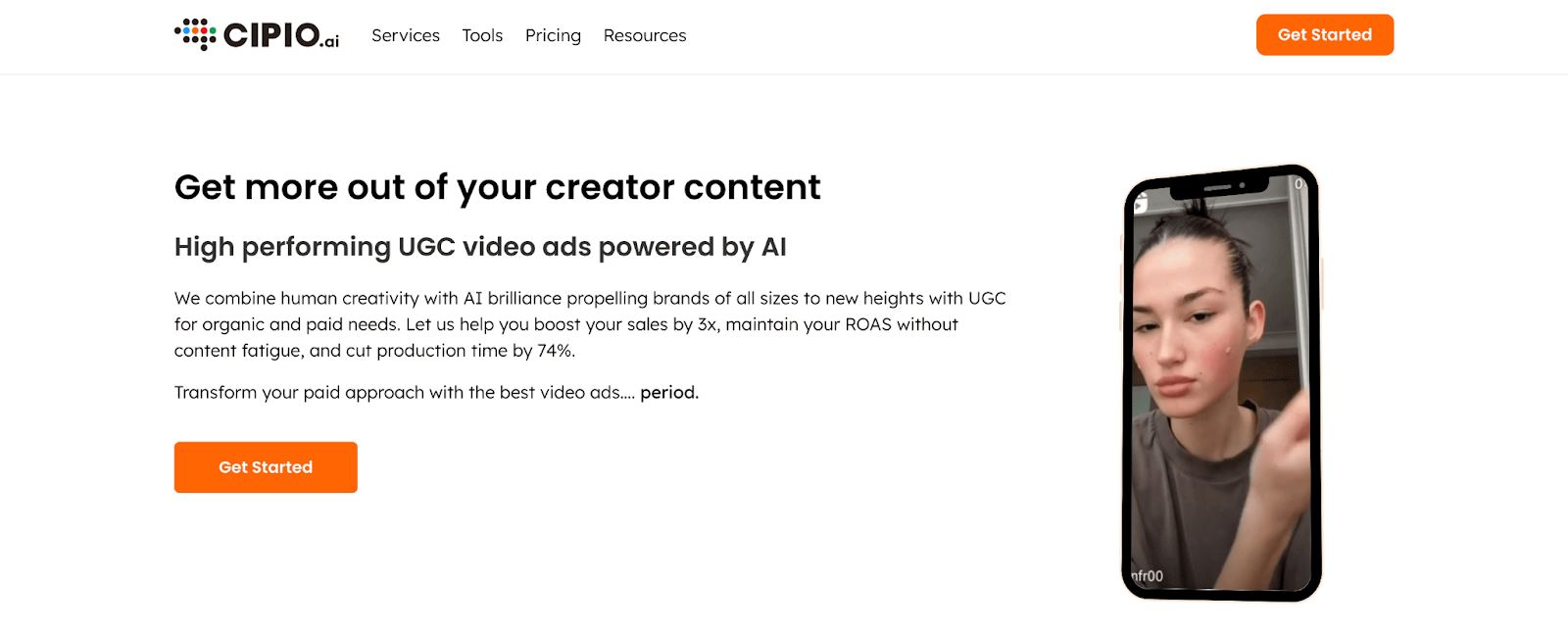
Best For: E-commerce brands on Shopify or Amazon that want to scale product gifting and leverage UGC-driven paid ad strategies without managing creator outreach or logistics internally.
Platform Coverage: Cipio primarily focuses on Instagram but enables brands to repurpose creator content across Facebook, TikTok, YouTube, and paid social ads.
Pricing:
Reviews: 4.9 / 5.0 (Glassdoor)
Ease of Use (UX/UI): Cipio’s interface is streamlined and easy to navigate, though customization is limited. Without a full self-serve dashboard, marketers often rely on Cipio’s internal team for outreach and analytics, which may feel restrictive for teams used to in-platform control.
Customer Support: Cipio provides proactive account management, with responsive support in sourcing and managing creators. Some users, however, wish for more visibility into creator interactions rather than relying solely on Cipio’s internal processes.
Stellar provides a broader influencer marketing toolkit with campaign management, CRM, and reporting, while Cipio specializes in Instagram-focused gifting and paid ad creative optimization. Stellar is more self-serve and modular, whereas Cipio operates as a managed service with less in-platform control.
For smaller teams needing affordability and direct workflows, Stellar is easier to adopt. But for eCommerce brands heavily invested in visual storytelling and paid ad performance, Cipio’s gifting model and UGC ad optimization make it a stronger, more specialized solution.
While Stellar remains a solid choice for basic influencer management, its limited integrations, shallow reporting, and rigid pricing often push brands to look elsewhere.
Alternatives like Upfluence, Captiv8, CreatorIQ, HypeAuditor, Grin, Modash, and Cipio each offer unique strengths—ranging from advanced data analytics and fraud detection to eCommerce integrations and UGC-driven ad optimization.
Among these options, Influencer Hero stands out as one of the best alternatives to Stellar. With its all-in-one approach, deep eCommerce integrations, AI-powered outreach, and premium customer support, it balances affordability with enterprise-level functionality. For D2C and eCommerce brands in particular, it provides a scalable solution that covers discovery, management, content, and reporting in one seamless platform—making it a strong contender for teams ready to move beyond Stellar’s limitations.

Many brands look for Stellar alternatives because of its limited eCommerce integrations, rigid pricing model, and less advanced reporting compared to competitors. If your team needs deeper automation, sales attribution, or more flexible contracts, exploring other platforms is a smart move.
For eCommerce and D2C brands, Influencer Hero is one of the strongest alternatives. It offers Shopify and WooCommerce integrations, automated gifting, affiliate tracking, and UGC management—all in one platform—making it especially suited for ROI-focused online retailers.
Stellar is praised for its simplicity and affordability but lacks the depth of enterprise platforms like CreatorIQ or the strong eCommerce integrations of Upfluence and Grin. Influencer Hero provides the balance between cost-effectiveness and advanced features, positioning itself as a more complete alternative.
Platforms such as CreatorIQ, HypeAuditor, and Captiv8 stand out for robust analytics and competitor benchmarking. However, Influencer Hero also offers real-time ROI tracking, campaign dashboards, and predictive analytics, giving growing brands an accessible yet powerful reporting solution.
Yes—platforms like Heepsy, Modash, and Influencer Hero offer flexible monthly or tiered plans without requiring rigid annual contracts. This makes them ideal for startups or scaling teams who want to avoid long-term lock-ins.



Schedule a Demo with one of our media experts below.